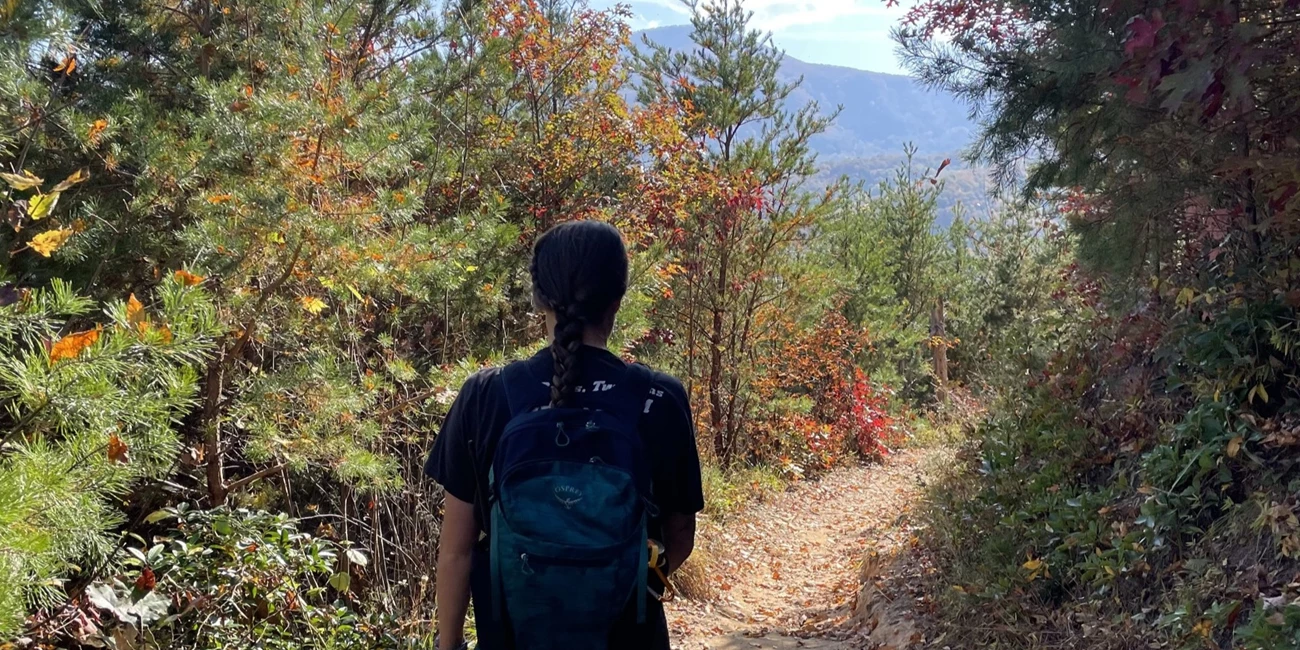
Kenzie Connor 
NPS Graphic Plan AheadHiking in the Smokies is one of the best ways to explore the park, however caution is always advised when exploring the backcountry. The park's backcountry is managed as a natural area, where the forces of nature determine trail conditions. Please be prepared for swollen streams, bridge washouts, downed trees, and trail erosion. Before You Go
What to BringWhat to bring on a hike depends on many factors, but there are ten essentials that you must have for any outing. Keep in mind that these are the minimum items everyone should carry while recreating outdoors. More supplies may be necessary depending on the duration of your hike and your specific needs. 
NPS Common Hazards in the SmokiesSlips, trips, and fallsWearing ankle-supporting boots is advisable. Hiking at nightAvoid hiking after dark. Hiking in the dark increases the risk of falls and wildlife encounters. If you're heading to a campsite, plan to arrive before nightfall. Always carry a headlamp; phone flashlights are not reliable. BearsBears in the park are wild, and their behavior can be unpredictable. While attacks on humans are extremely rare, it is important to treat encounters with caution. Hikers are allowed to carry bear spray for protection against wildlife. However, bear spray should never be used on people, tents, or gear. Proper bear spray is a commercial product labeled as such, registered with the Environmental Protection Agency, and containing 1% to 2% capsaicin and related compounds. If you use bear spray in the park, observe a bear behaving unusually, or spot a bear in a developed area, such as a picnic area or campground, report it to a ranger immediately. Heat-related illnessHigh temperatures and physical activity can lead to heat-related illnesses, which range from mild to life-threatening. Signs of heat exhaustion include heavy sweating, weakness, dizziness, nausea, headaches, and cool, clammy skin. Heat stroke is much more serious and includes symptoms like confusion, slurred speech, red or hot skin, a rapid pulse, and fainting. Heat stroke is a medical emergency—call 911 immediately. To prevent heat-related illness, drink plenty of water—about 3 to 4 quarts per day. Take regular breaks, rest in the shade, and avoid hiking during the hottest part of the day. Wear lightweight, breathable clothing, and know your limits. HypothermiaBe ready for sudden weather changes—cool, wet, and windy conditions can lead to hypothermia, even in summer. Hypothermia lowers the body’s core temperature and can impair physical and mental function. Stinging insectsYellowjacket wasps are of particular concern. They build nests in the ground near trails and streams and can be aggressive if disturbed. Avoid wearing fragrances, as these can attract yellowjackets. Stings can cause local swelling and, in some people, severe allergic reactions. Those at risk should carry an epinephrine kit.

Ella Voorhees Stream crossingsHeavy rain can cause streams to swell, making crossings risky. Always use good judgment and do not attempt to cross flooded streams. If a swollen stream blocks your route, backtrack to the nearest campsite or trailhead or wait for the stream water to recede. When crossing streams, wear shoes for protection and carry a sturdy stick for balance. Remember to loosen the waist strap of your pack for easy removal if necessary. Untreated drinking waterAlways treat stream water before drinking, as it may contain the protozoan Giardia lamblia. This parasite can cause intestinal issues weeks after consumption. The safest ways to treat water are to boil it for one minute or use a filter that removes particles as small as 1 micron. Poison ivyPoison ivy is a common native plant in the park, often found along roads and disturbed areas. It can grow as a shrub or vine with three-leaflet compound leaves. The plant contains a skin irritant that can cause an allergic rash, sometimes severe, after contact. If exposed, wash the area with soap and water immediately. Trees and limbsBefore resting or setting up camp, look around for any trees or branches that could fall. Avoid areas where tree falls are a risk. TicksCheck for ticks at least every 24 hours or after spending time in the backcountry. Ticks can transmit diseases like Lyme disease. When removing a tick, use tweezers and ensure you get the entire tick, including its head. MosquitoesBe prepared with insect repellent, especially in areas near standing water, where mosquitoes are plentiful. Venomous snakesThe Smokies are home to two venomous snakes: the northern copperhead and the timber rattlesnake. While bites are rare, visitors should be cautious about where they place their hands and feet. Fortunately, no fatalities from snake bites have been reported in the park. TheftDo not leave valuables visible in your vehicle. Take them with you or hide them in your car. |
Last updated: December 17, 2025
